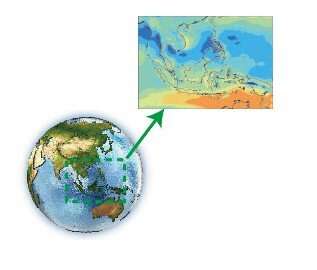Customization and recommended configuration of RegCM4.7 over the CORDEX Southeast Asia Domain. Credit: Wang Zhengqi
Southeast Asia has experienced impacts of climate change in recent decades, including rising temperatures and increasing extreme events. Reliable climate change information in the future is very important for assessing the impacts and implementing adaptation measures, thus lowering the risks from climate change over the region. Due to the complex topography and numerous islands in the region, applying high-resolution regional climate models is of great importance. However, different factors, such as the dominance of the monsoon climate, a large proportion of the region being covered by ocean, etc., make it difficult to model and reproduce the present climate over the region.
"As a first step towards a more reliable climate change projection, we need to test and customize models," says Prof. Xuejie Gao, a Senior Scientist at the Institute of Atmospheric Physics, Chinese Academy of Sciences.
He and his Ph.D. Student, Zhengqi Wang, conducted experiments with the latest version of a regional climate model, RegCM4.7, with a focus on the above concerns. Firstly, they compared the simulations of the model using different convective parameterization schemes; namely, Tiedtke and Emanuel.
"To capture the monsoon rainfall, proper cumulus convective parameterization selection is probably the most crucial aspect," explains Professor Gao. They found that both schemes reproduce well the temperature over land, and the spatial pattern and amount, as well as the seasonal evolution of precipitation. Better performance of Tiedtke is evident compared to Emanuel, in particular over the ocean. The findings are published in Atmospheric and Oceanic Science Letters.
The team modified the calculation of humidity roughness length in the sea surface flux scheme, and applied a simplified correction function when the wind speed is strong to introduce the effects of spray on heat flux calculation over the ocean. This led to further improvement, albeit to a limited extent, of the model in reproducing the present climatology, but nonetheless will potentially help in simulating weather and climate extremes. This is identified as the optimal model configuration of RegCM4 over the region.
"In future work, we intend to use this model configuration in climate change projections over the Southeast Asia region towards a goal to provide more scientifically robust information on climate change for the region," concludes Zhenqi Wang, the lead author of the study.
More information: Zhengqi WANG et al, Assessing the sensitivity of RegCM4 to cumulus and ocean surface schemes over the Southeast Asia domain of the coordinated regional climate downscaling experiment, Atmospheric and Oceanic Science Letters (2019). DOI: 10.1080/16742834.2020.1697615
Provided by Chinese Academy of Sciences
























